OTT media is getting increasingly crowded. Be it the music or the video format.
Disney unveiled its video-on-demand streaming service named Disney+. Roughly 24 hours later, 10 million users signed up on the platform. What makes this win impressive is these are not even global numbers – the service was just launched in the US, Canada, and the Netherlands.
Undoubtedly, media consumption has increased substantially in digital formats. As per a KPMG study on digital media consumption landscape in India:
- An average user spends 70-75 mins every day consuming video content
- The average viewing frequency of consumers is around 12.5 times/week
- A single session of viewing content lasts around 40 minutes on average
- Users are active on at least 2 OTT platforms and have a paid subscription of at least 1 platform, and
- Around 80% of the overall content consumption is happening on mobile devices
This kind of growth brings with it a lot of opportunities and challenges that we are going to discuss in this post.
What is OTT Video Personalization?
OTT video personalization is tailoring streaming content to match individual viewer preferences, creating a personalized and engaging watching experience.
By tapping into viewer data—such as watch history, genre preferences, and content ratings—OTT personalization recommends and curates content uniquely for each user.
This customization guarantees that viewers encounter content perfectly aligned with their interests, resulting in heightened satisfaction and extended watch times.
OTT video personalization stands out as a vital tool, streamlining content discovery and providing a delightful, uniquely tailored journey through the expansive realm of online entertainment. It’s not just about what’s on-screen; it’s about ensuring that what’s on-screen resonates uniquely with each viewer.
The Current Landscape of the OTT Media Industry
It is worth noting that the industry has already become quite competitive. It won’t be an exaggeration to say that we are witnessing a war in the OTT media world right now. And in this war – Netflix, Spotify, and Amazon are the top contenders.
While the big players are definitely acing it with their wide variety of content and distinct UI/UX experiences, they are facing stiff competition from several regional OTT players as well, such as iflix, HOOQ, Jio Saavn, Wynk, Hotstar, Eros Now, Voot, and Viu in Southeast Asia, Starz Play in the Middle East and North Africa, Hayu, Maxdome, Watchever, Wuaki, Viaplay and HBO Nordic in Europe.
It’s interesting to note that in some cases, the market share of these regional players even surpasses that of the big players like Netflix and Amazon Prime.
A key differentiator in the success of these players seems to be the understanding of the audience and serving them with relevant content.
The first phase of growth of OTT platforms came from the increasing penetration of smartphones and affordable data plans. Now, during the next phase of growth, AI-based personalized recommendations are expected to play a significant role.
The success of any OTT platform depends on these key factors – content, discovery, user interface, and user experience. OTT personalization here works on all these factors and simultaneously helps brands address marketing challenges related to:
- The high cost of customer acquisition
- Showcasing relevant content
- Increasing average user content consumption
- Converting freemium users to paid subscribers
- Competitive marketplace
The giants in this business (Netflix, YouTube, and Spotify) have been able to surpass some of these challenges with powerful recommendation engines supported by AI & ML technology. This is also something that a lot of other market players are trying to replicate.
What is also needed is for brands to understand that they need to ensure that they:
| Deliver the right content | > | To the right users | > | At the right time | > | Across all touch points |
How can OTT Personalization Drive User Acquisition, Retention and Engagement?
There are two ways to go about it –
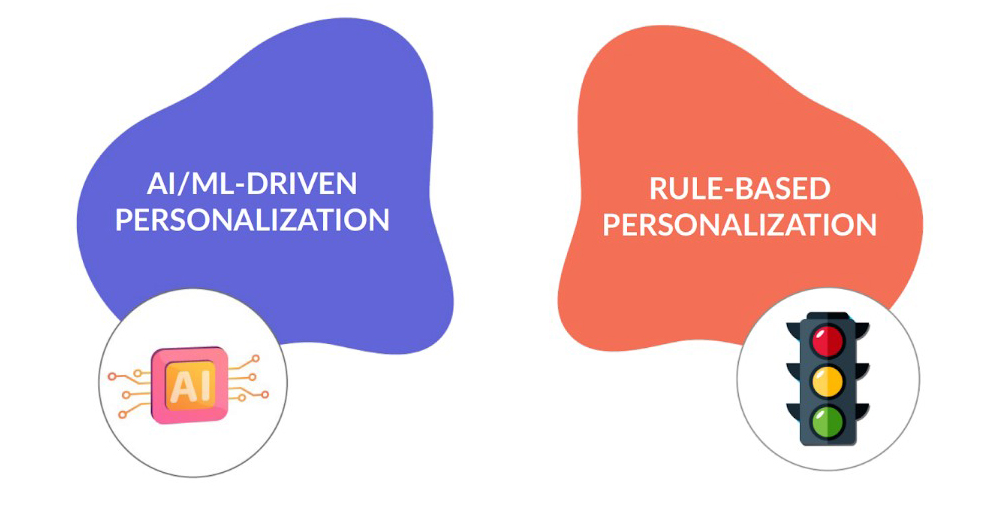
1. Driving AI-Driven Personalization
AI/ML has been around for a long time now. These machines can interact with you, understand you, reason with you, and respond in a manner similar to humans.
This advancement has been quite relevant to digital marketers – they can analyze large sets of data to identify behavioral affinities and create insights-driven personas.
Using machine learning algorithms, actions are anticipated for these personas. They are matched with relevant promotions, pricing offers, and content and drive them to specific experience paths.
Netcore’s home-grown patented AI/ML engine – RAMAN, also captures customer eyeball data that improves these behavioral predictions further by 20%. Using it, a marketer can expect to deliver 8-13% higher conversion rates by personalizing the entire customer journey.
Some of the key features of RAMAN:
- Industry-standard collaborative and content filtering algorithms with embedding to make it scalable to handle a very large amount of data
- Context layers to add the nuance of date/time, location, and devices while viewing/listening
- Temporal layers to cater to the recency of interactions, order, and periodicity of content consumption
- Developed with a neural network to enable real-time learning and ease of adding new feature sets for different use cases
- Seen but not clicked –and ”not-seen-not-clicked” signals give 20% better predictions
2. Providing Recommendations for AI-driven Personalized Experience
An important consideration in media OTT personalization is that it should be applied to the entire customer journey, covering all the key touchpoints of user interaction. Here’s how you can approach it:
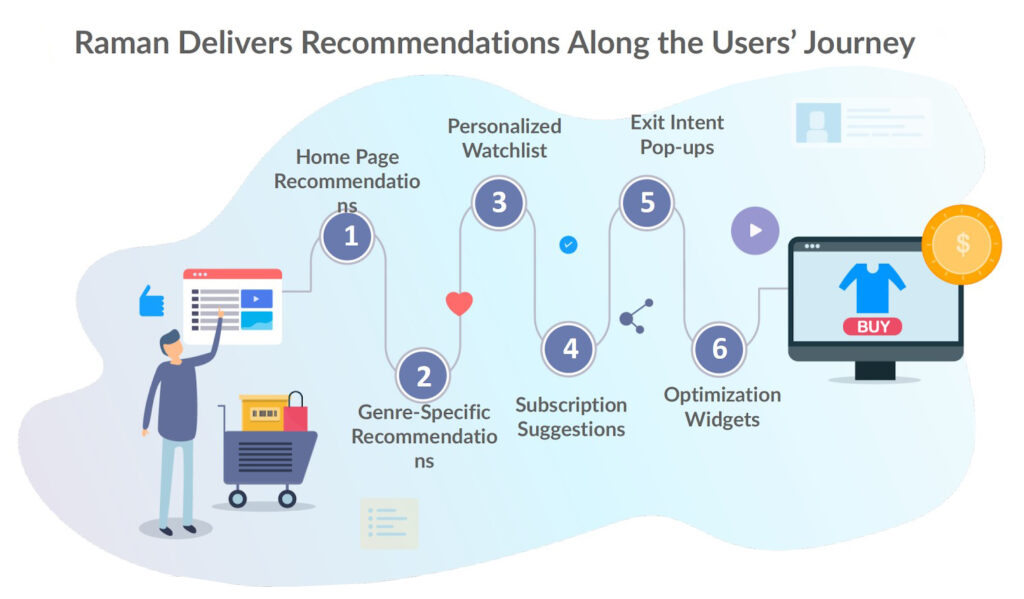
a. Homepage Recommendations
A user is likely to spend most of their time on this very page. It is also where you will have the maximum traffic on your website.
Hence, it makes sense to have personalized homepage for your users, as it improves the relevance of the content, resulting in better engagement.
You can organize these recommendations into various sections on your homepage, such as ‘Watch next’ and ‘You may like’ sections. These recommendations can be based on their viewing or listening history or real-time data. Personalized recommendations on the homepage have the possibility of boosting CTRs by 80-90%!
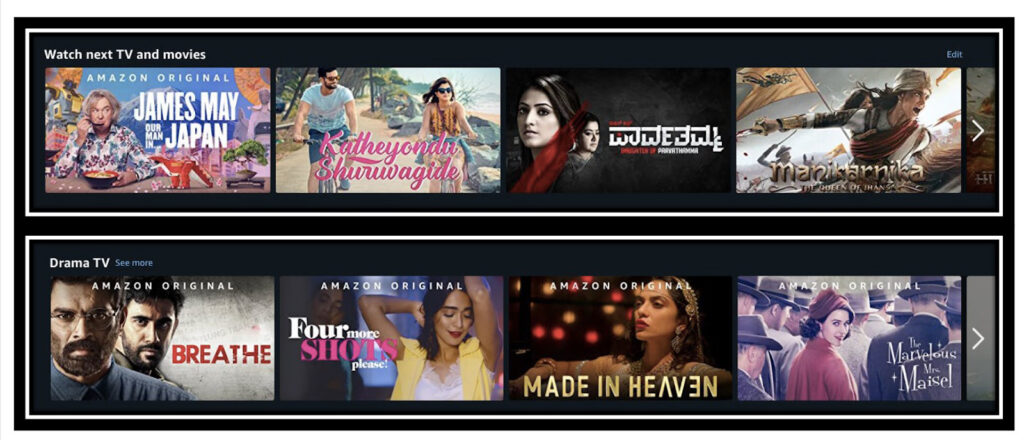
b. Genre-Specific Recommendations
You can provide recommendations based on viewing/listening history or real-time data.
In the example below, you can see that the recommendations are aligned with a user’s preference for the ‘romance’ genre. This works on the idea of boosting the visibility of relevant content, which ultimately translates into more clicks and consumption.
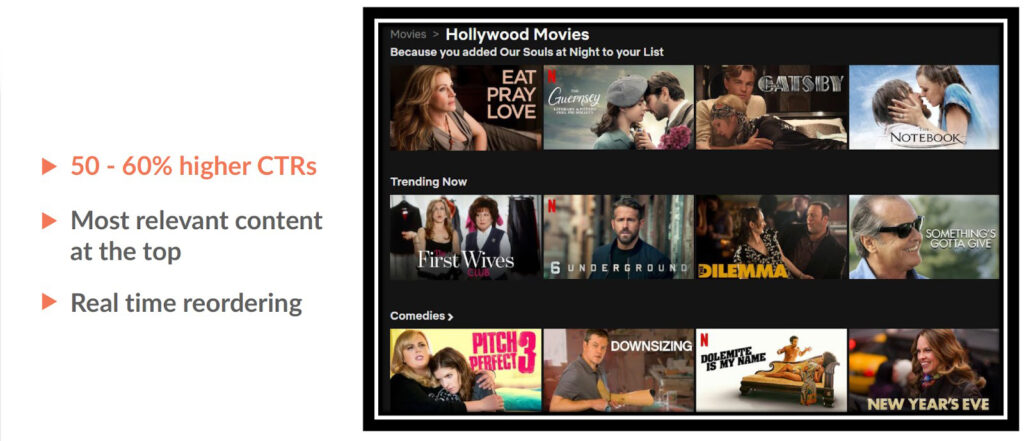
c. Personalized watch list/playlist
You can personalize the watch list/playlist for your users.
This can be based on a variety of factors, such as when a user launches the app or lands on the website, the kind of content they consume, the propensity to consume a certain genre, and many more.
A personalized watch list/playlist can improve the CTR by at least 80-110% on average.
Note that you can also use this space to showcase gated content, which is a great opportunity to convert your freemium customers into paid customers.

d. Personalized emails
Sending personalized emails rides on the philosophy of personalizing the entire customer journey. In the case of personalized email, you will set up a system for different audience segments or individuals who will receive different versions of the communication from this channel.
Personalized recommendations through email can give a CTR increase of around 60-80%.
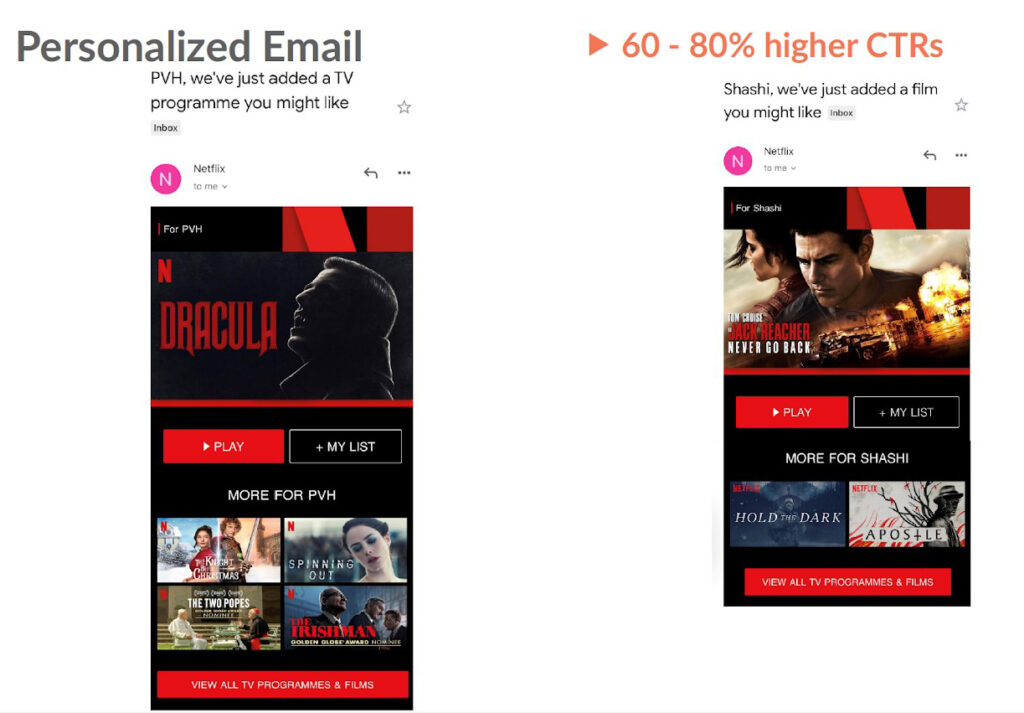
e. Personalized Notifications
It is another great channel to deliver highly personalized and contextual recommendations to users at the right time. Since push notification capture user attention immediately, it is important to make sure your notifications are timed well and are only sent to the user when they are most likely to view your content.
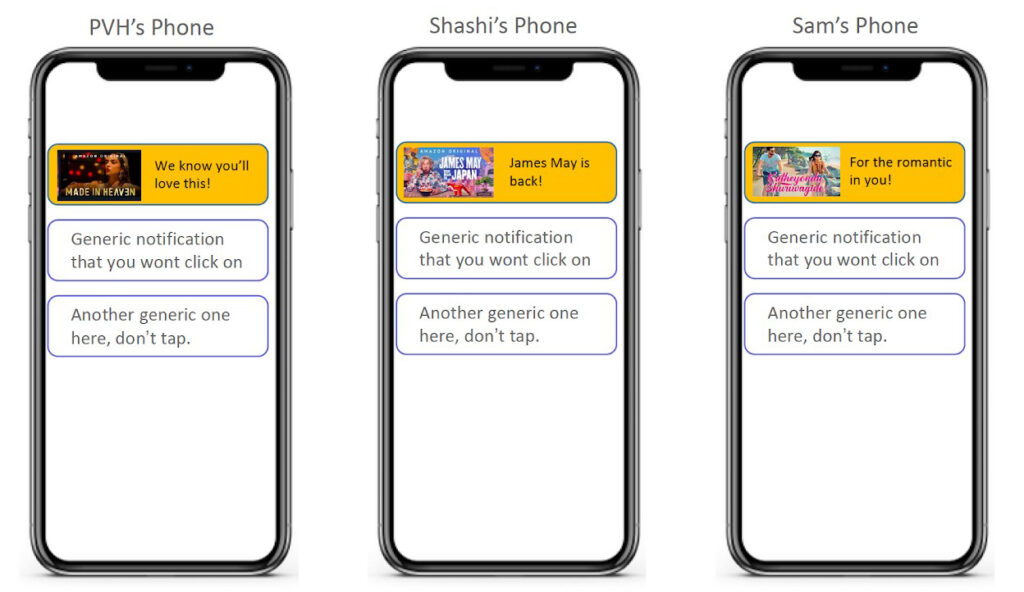
How Does Rule-Based Personalization Work?
Rule-based personalized relies on the marketer’s input to control the personalization instead of the AI/ML engine doing the heavy lifting for you. It requires manual effort from the marketer to understand the user’s preferences and personalize their experience by selecting recommendations most suitable for them.
This kind of marketer-led personalization can be based on user demographics like location, time, device type, and many other similar parameters. You can also be selective in how you personalize your website based on specific user actions.
Types of Recommendations for Rule-Based Personalized Experience
a. Rearrange Content Options
You can select a couple of content options that you think are relevant for your audience and display them on your website homepage. It relies largely on the possibility that your users might be curious about the content that you display and, therefore, engage with it.

b. Personalization based on Geo-location
You can also personalize the entire website experience for your users based on the user’s geolocation. This allows you to localize the content based on the location from where the user might be logging in. You can also display content basis the language preferences of your users.
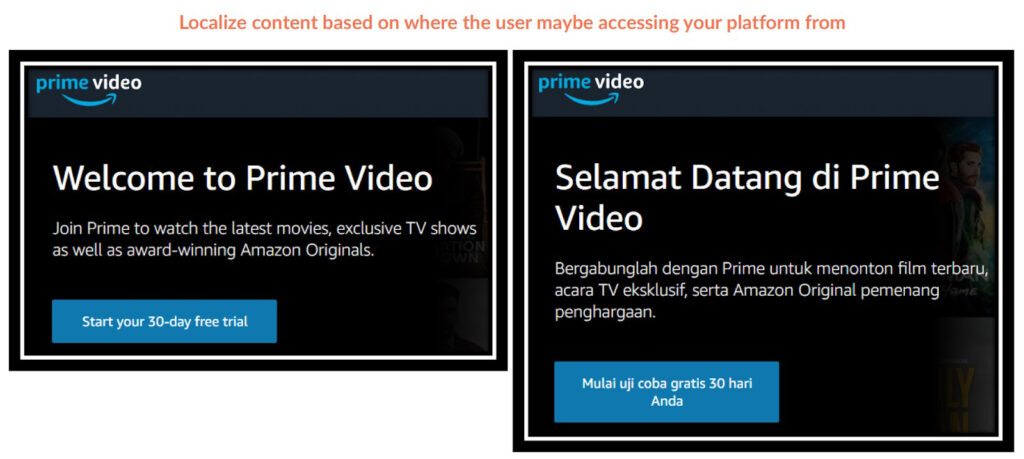
What to Choose- AI-driven Personalization or Rule-based Personalization?
In the case of AI/ML-driven personalization, marketers do not need to intervene as it works dynamically. Once the system is in place, it learns from the user behavior and makes personalization decisions on its own.
It is largely suitable for scenarios wherein you want to personalize a large amount of content or have several content categories.
On the other hand, rule-based personalization is meant to provide the marketer with the most control over personalization decisions. Since this method is not dynamic, it relies on certain predefined rules that the marketer can set and manually control the personalization of the website.
Both of these personalization methods can be applied to websites of any size and volume of traffic.
Conclusion
Media OTT brands have immense opportunities to tap into in the near future. As much the competition is going to be stiff, setting oneself apart from other players would require an effort to understand the audience and truly cater to their needs and preferences.
Personalization, in this case, becomes an important ally for them that will provide them with the much-needed stickiness to their platform as well as the content.
 Holiday Sales Are Won Now — Grab the 2025 Holiday Marketing Guide to Unlock More Revenue.
Holiday Sales Are Won Now — Grab the 2025 Holiday Marketing Guide to Unlock More Revenue. 








